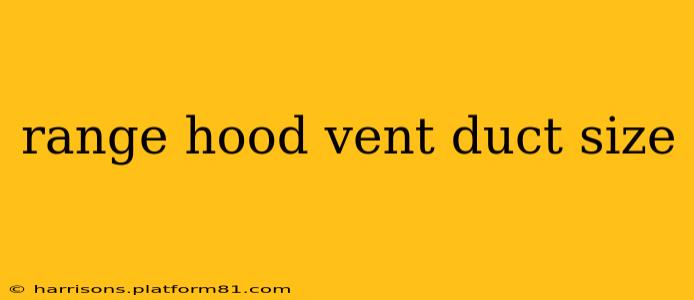Choosing the right range hood vent duct size is crucial for effective kitchen ventilation. An improperly sized duct can lead to poor performance, resulting in grease buildup, smoke lingering in the air, and even potential fire hazards. This guide will help you understand the factors influencing duct size selection and ensure your kitchen remains safe and clean.
What Size Vent Duct Do I Need for My Range Hood?
The ideal vent duct size depends on several key factors:
-
CFM (Cubic Feet per Minute) Rating of Your Range Hood: This is the most critical factor. The CFM rating indicates the amount of air your range hood can exhaust per minute. A higher CFM rating generally requires a larger duct size to accommodate the increased airflow. Check your range hood's specifications for its CFM rating. Don't rely on the marketing materials; find the actual technical specifications.
-
Length of the Duct: Longer ducts increase resistance to airflow. A longer duct will require a larger diameter to maintain efficient exhaust. Every bend or turn in the duct also adds resistance, further necessitating a larger diameter.
-
Number of Bends and Turns: As mentioned above, each bend restricts airflow. The more bends, the larger the duct needs to be to compensate for the increased friction. Straight ducts are always the most efficient.
-
Type of Duct Material: Smooth, round metal ducts are generally the most efficient. Flexible ducts offer convenience for installation but can significantly restrict airflow due to their corrugated interior. If using flexible ductwork, consider using a larger diameter than you would with rigid metal ducting.
How to Determine the Correct Range Hood Vent Duct Size?
There's no single magic formula, but here's a general guideline:
-
For range hoods with CFM ratings under 300: A 4-inch diameter round duct is often sufficient, especially for shorter duct runs with minimal bends.
-
For range hoods with CFM ratings between 300 and 600: A 6-inch diameter round duct is typically recommended.
-
For range hoods with CFM ratings over 600: An 8-inch diameter duct or larger might be necessary, depending on duct length and configuration. Always consult with a professional HVAC technician for installations requiring larger ducts.
Important Note: It's generally better to err on the side of a larger duct size. A slightly oversized duct will still function effectively, while an undersized duct will significantly reduce the range hood's efficiency.
What Happens if My Range Hood Vent Duct is Too Small?
Using a duct that is too small for your range hood's CFM rating will lead to several problems:
-
Reduced Exhaust Efficiency: The range hood won't be able to remove smoke, grease, and odors effectively, resulting in a smoky or greasy kitchen.
-
Increased Backdrafting: The reduced airflow can cause a backdraft, pushing smoke and fumes back into the kitchen.
-
Grease Buildup: Insufficient airflow allows grease to accumulate in the ductwork, increasing the risk of a fire.
-
Decreased Appliance Lifespan: The range hood motor will have to work harder, leading to increased wear and tear and potentially reducing its lifespan.
Is it better to use flexible or rigid ductwork?
Rigid metal ductwork is far more efficient because it offers less resistance to airflow than flexible ductwork. However, flexible ductwork can be easier to install in challenging spaces. If you choose to use flexible ductwork, ensure that you select a diameter larger than what would be used for rigid ductwork to compensate for the increased friction. Always minimize bends and curves to improve airflow even with flexible ducting.
Can I use a square duct instead of a round one?
While square ducts are sometimes used, round ducts are generally more efficient because they offer less surface area for friction. A square duct of the same cross-sectional area as a round duct will still have a smaller effective diameter due to the corners, resulting in decreased efficiency.
What if I'm unsure of the correct size?
If you're unsure about the appropriate duct size for your range hood, it's best to consult with a qualified HVAC professional. They can assess your specific situation and recommend the optimal duct size and configuration for efficient and safe kitchen ventilation. Don't hesitate to seek professional help; kitchen ventilation is crucial for safety and cleanliness.
